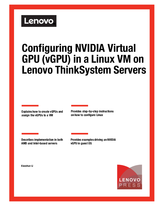Author
Published
10 May 2022Form Number
LP1585PDF size
21 pages, 422 KBAbstract
Virtual GPU (vGPU) is the method of virtualizing a GPU adapter installed in a server so that the physical GPU can be shared by multiple virtual machines running on that server. This method assigns the virtual devices to multiple guest operating systems, and the guest OSes share the performance of the single physical GPU.
This paper provides guidance on enabling vGPU and making it available to VM running in a Kernel Virtual Machine (KVM)-based OS. The paper is for Linux administrators wishing to use a vGPU in a ThinkSystem™ server to pass through to a VM. For our evaluation, we implement Red Hat Enterprise Linux 8.5 both as the host OS and guest OS, and show how to virtualize the resources of an NVIDIA T4 GPU.
Table of Contents
Introduction
Setup NVIDIA vGPU
Create NVIDIA vGPUs
Installing the vGPU driver on the Linux guest OS
Deleting a vGPU on Linux with KVM
Prerequisites for using NVIDIA vGPU on the NVIDIA Ampere architecture
Resources
To view the document, click the Download PDF button.
Configure and Buy
Full Change History
Course Detail
Employees Only Content
The content in this document with a is only visible to employees who are logged in. Logon using your Lenovo ITcode and password via Lenovo single-signon (SSO).
The author of the document has determined that this content is classified as Lenovo Internal and should not be normally be made available to people who are not employees or contractors. This includes partners, customers, and competitors. The reasons may vary and you should reach out to the authors of the document for clarification, if needed. Be cautious about sharing this content with others as it may contain sensitive information.
Any visitor to the Lenovo Press web site who is not logged on will not be able to see this employee-only content. This content is excluded from search engine indexes and will not appear in any search results.
For all users, including logged-in employees, this employee-only content does not appear in the PDF version of this document.
This functionality is cookie based. The web site will normally remember your login state between browser sessions, however, if you clear cookies at the end of a session or work in an Incognito/Private browser window, then you will need to log in each time.
If you have any questions about this feature of the Lenovo Press web, please email David Watts at dwatts@lenovo.com.

